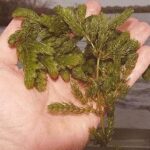Coontail
Other Common Names: hornwort, coon's tail
(Ceratophyllum demersum)
Native
Coontail has finely divided leaves arranged in whorls of five to 12 and is bushier towards the top. It has a hollow stem and lacks true roots.
Management Options
Description
Coontail is one of the most common aquatic plants in the world. This plant lacks true roots, though it may be loosely anchored to the sediment by pale modified leaves. The central stem of the plant is hollow. Stems can grow up to 11 feet long and form large masses; they are brittle yet flexible. The plant’s medium to dark green leaves grow about a half inch long, spiny, and forked. The straight flat leaves are arranged in whorls of five to 12 at a node. Whorls are more closely spaced near the ends of the branches. Upper leaves may reach the surface of the water. Leaves are separated all the way to the midrib, somewhat resembling pine needles. There are several tiny teeth on coontail leaves, making the plant feel rough to the touch. coontail flowers, though the blooms are difficult to see at the base of the leaves. The plant may be long and sparse but is often bushy near the tip with an appearance like a racoon’s tail. Coontail grows in quiet waters.
Most often coontail is mistaken for watermilfoil, which has spikes of flowers and fruits that emerge from the water’s surface, while coontail is entirely submerged.
Location
Coontail can be found across the United States.
Propagation
fragments



